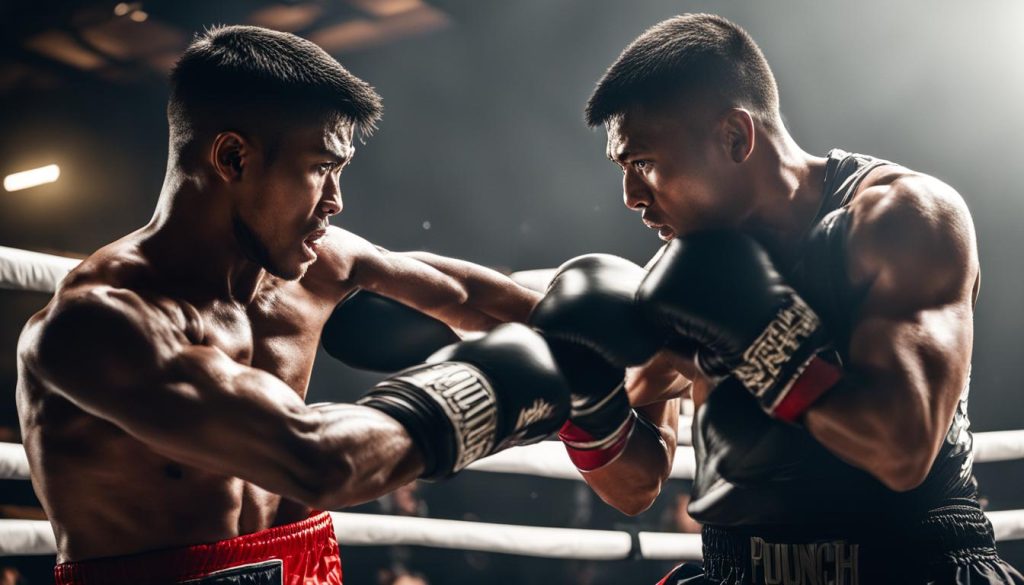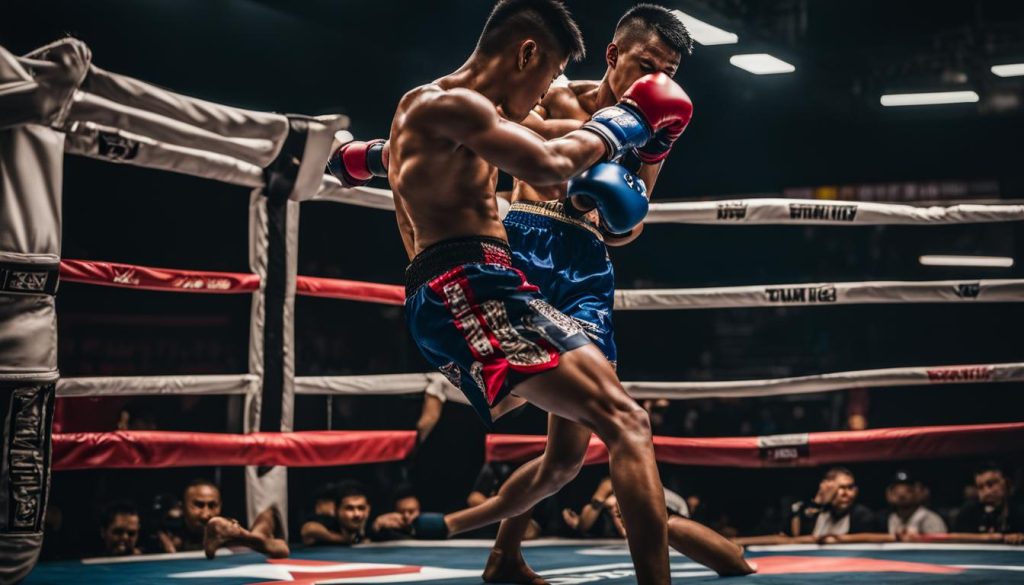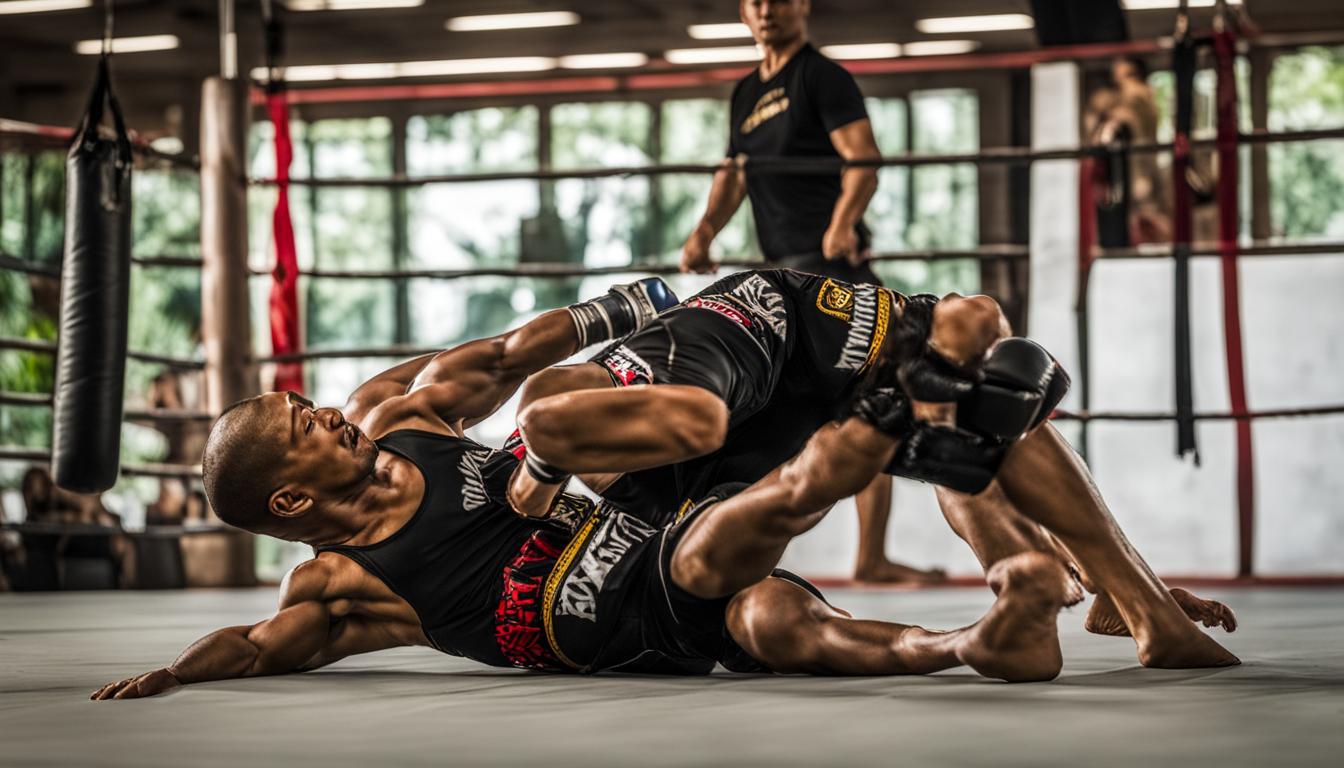Muay Thai, also known as the “Art of Eight Limbs,” is considered the most effective striking discipline. It involves the use of fists, elbows, knees, and legs. Beginners often find the world of Muay Thai intimidating, but it is a welcoming environment with friendly coaches and training partners. This guide will take you through the essential moves of Muay Thai and help you start your journey in this electrifying martial art.
Key Takeaways:
- Mastering your Muay Thai stance and footwork is essential for balance and stability.
- Punches such as the jab, cross, hook, and uppercut are fundamental for setting up combinations and generating power.
- Kicks like the low kick, roundhouse kick, switch kick, and push kick are strong weapons in Muay Thai.
- Knee strikes, including the straight knee, diagonal knee, curving knee, and small knee, are iconic in Muay Thai.
- Elbow strikes like the horizontal elbow strike, uppercut elbow strike, downward elbow strike, and diagonal elbow are highly effective techniques.
Chapter 1: Stance And Footwork
Mastering your stance and footwork is essential in Muay Thai. It is the foundation upon which all other techniques are built. A proper Muay Thai stance ensures balance, stability, and allows for efficient movement and power generation.
To achieve a strong stance, position your lead foot in the upper left square and your rear foot in the bottom right square. Maintain a tight posture with a slight bend in your knees, which will aid in agility and power. Keep your guard up to protect your face, with your elbows slightly outwards. Remember to keep your heels off the floor to maintain balance and mobility.
Footwork is equally important in Muay Thai. Step forward and backward smoothly, ensuring that you never cross your feet. This will prevent you from losing balance and getting caught off guard. Keeping your heels off the floor will allow you to pivot and change directions quickly. Practice these fundamental footwork techniques to become more fluid and agile in the ring.
Table: Common Mistakes in Stance and Footwork
| Mistake | Description | Correction |
|---|---|---|
| Leaning too far forward | Loses balance and decreases power | Maintain an upright posture with a slight forward lean |
| Feet too close together | Lacks stability and limits mobility | Keep feet shoulder-width apart for better balance |
| Heels flat on the floor | Reduces agility and impedes movement | Stay on the balls of your feet for quicker pivots and transitions |
| Crossing the feet | Risk of losing balance and getting tripped | Step with intent and maintain proper distance between your feet |
By mastering your stance and footwork, you will have a solid foundation to build upon as you progress in your Muay Thai journey. Consistent practice and attention to detail will help you develop the essential skills required to excel in this electrifying martial art.
Chapter 2: Punches
In Muay Thai, punches are crucial techniques that allow fighters to strike with speed, precision, and power. Understanding the different types of punches and how to execute them effectively is essential for any practitioner. This chapter will explore the fundamental punches in Muay Thai, including the jab, cross, hook, and uppercut.

Jab
The jab is a quick and straight punch thrown with the lead hand. It serves as both an offensive and defensive technique, allowing fighters to gauge distance, disrupt their opponent’s rhythm, and set up combinations. The jab should be delivered with speed and accuracy, using the shoulder to generate power while maintaining a strong guard to protect against counterattacks.
Cross
The cross is a powerful punch thrown with the rear hand. It involves rotating the hips and shoulders explosively, transferring the body’s weight into the punch. The cross is a key weapon for generating knockout power and is often used as a follow-up to the jab. Proper technique is essential to ensure maximum impact and maintain balance and stability.
Hook
The hook is a close-range punch delivered in a circular motion. It is primarily aimed at the head or body of the opponent, making it an effective technique for inflicting damage and disrupting their defense. Executing the hook requires powerful rotation of the hips and pivoting on the lead foot to generate torque. It is important to maintain proper form and protect the other side of the face while throwing the hook.
Uppercut
The uppercut is an upward punch targeted at the chin or body of the opponent. It is a devastating punch in close combat situations, as it can catch the opponent off guard and deliver significant impact. To execute the uppercut, fighters should bend their knees and generate power from the legs, driving the punch upward with a twisting motion of the hips and torso.
In conclusion, mastering the punches in Muay Thai is essential for effective striking and setting up combinations. The jab, cross, hook, and uppercut each have their unique applications and should be practiced diligently to develop speed, accuracy, and power. Understanding the proper mechanics and technique behind each punch will enable fighters to execute them effectively in the heat of battle.
Chapter 3: Kicks
When it comes to Muay Thai, kicks are one of the most powerful and effective techniques you can master. They not only deal significant damage to your opponent but also score the most points in a fight. In this chapter, we will dive into the different types of kicks and how to execute them with precision and power.
1. Low Kick
The low kick is a devastating strike that targets your opponent’s thigh. By repeatedly attacking their leg, you can wear them down and limit their mobility. To perform a low kick, pivot on your supporting foot and swing your rear leg hard into your target. Make sure to keep your shin bone flush with your opponent’s thigh for maximum impact.
2. Roundhouse Kick
The roundhouse kick is a versatile strike used to target your opponent’s midsection. Start by raising your knee and pivoting on your supporting foot, then whip your leg across your body to strike with the top or ball of your foot. This kick generates significant power and is effective for both offensive and defensive purposes.
3. Switch Kick
The switch kick is a deceptive technique that confuses your opponent by switching your stance before delivering the kick. Begin in your orthodox stance, then quickly switch your lead foot to the rear as you swing your leg forward. This sudden change in position can catch your opponent off guard, allowing you to land a powerful kick to their body or head.
4. Push Kick
The push kick, also known as the teep, is a front kick used to create distance or push your opponent back. To execute a push kick, raise your knee, extend your leg, and thrust your foot forward, aiming for your opponent’s midsection. This kick is particularly effective in close-quarters situations or when you need to create space to assess the situation.
| Kick | Target | Technique |
|---|---|---|
| Low Kick | Thigh | Pivot on supporting foot, swing rear leg into target |
| Roundhouse Kick | Midsection | Raise knee, pivot on supporting foot, whip leg across body |
| Switch Kick | Body or head | Switch stance, swing leg forward |
| Push Kick | Midsection | Raise knee, extend leg, thrust foot forward |
Mastering these kicks will not only enhance your offensive capabilities but also build a strong foundation for more advanced techniques. Remember to practice proper form, footwork, and technique to execute these kicks with efficiency and power. Combine them with other striking techniques to create devastating combinations that can overpower your opponents in the ring.
Chapter 4: Knee Strikes
In Muay Thai, knee strikes are iconic and devastating techniques utilized by fighters. They are highly effective in close combat situations and can cause significant damage to the opponent. There are several types of knee strikes in Muay Thai, each with its own purpose and execution.
Straight Knee
The straight knee is a powerful thrusting strike delivered with the knee. It is commonly aimed at the midsection or face of the opponent. To perform a straight knee, the fighter drives their knee straight forward, making contact with a solid force. This technique requires proper hip rotation and timing for maximum impact.
Diagonal Knee
The diagonal knee strike is executed at an angle, targeting the ribs or thighs of the opponent. It involves stepping in with one leg while bringing the opposite knee upward and across the body. The diagonal knee strike is effective in close range combat, allowing the fighter to generate power and strike at vulnerable areas of the opponent’s body.
Curving Knee
The curving knee strike is delivered by bringing the knee up and curving it to the side, targeting the head or neck. It is a deceptive and powerful technique that can catch the opponent off guard. The curving knee strike is executed with a twisting motion of the hips, generating significant force upon impact.
Small Knee
The small knee strike is a quick tap with the knee, targeting the thigh or midsection of the opponent. It is a versatile technique that can be used to disrupt the opponent’s balance or sap their strength. The small knee strike requires precision and speed, allowing the fighter to score points and create openings for further attacks.
Mastering knee strikes in Muay Thai requires practice, technique, and an understanding of timing and distance. These strikes are effective weapons that can deliver devastating blows and control the outcome of a fight. By incorporating knee strikes into their arsenal, fighters can become more well-rounded and formidable opponents in the ring.
Chapter 5: Elbow Strikes
Elbow strikes play a crucial role in the arsenal of techniques in Muay Thai. They are powerful and devastating, capable of inflicting significant damage on opponents. Mastering the various elbow strikes will greatly enhance your overall striking proficiency in the art of Muay Thai.
Horizontal Elbow Strike
The horizontal elbow strike is a versatile technique that involves bringing the elbow across the body to target the opponent’s face or collarbone. It is executed with a swift and explosive motion, generating maximum force. This strike is especially effective in close-range combat, allowing you to quickly incapacitate your opponent.
Uppercut Elbow Strike
The uppercut elbow strike is executed by driving the elbow upward, targeting the opponent’s chin or nose. It is a devastating technique that can cause significant damage and potentially end a fight. The power generated from the legs and core is transferred into the elbow, making it a highly effective strike in close-quarters combat.
Downward Elbow Strike
The downward elbow strike is a powerful technique that targets the opponent’s forehead, nose, or collarbone. It is executed by striking downward with the elbow, using gravity and body weight to maximize the impact. This strike is highly effective in close-range situations, allowing you to dominate the fight and create openings for further attacks.
Diagonal Elbow Strike
The diagonal elbow strike involves striking at an angle, targeting various areas of the opponent’s body. This technique can be executed with either the lead or rear elbow, depending on the situation. The diagonal elbow strike is a versatile move that can be used to attack the head, ribs, or thighs of your opponent, making it an essential technique in close-quarters combat.
Mastering the different elbow strikes in Muay Thai requires consistent practice and proper technique. These techniques can be incorporated into combinations and setups to maximize their effectiveness. Remember to always train under the guidance of a qualified instructor and prioritize safety during practice.

Chapter 6: Defensive Blocks
In the world of Muay Thai, defense is just as important as offense. Learning effective defensive blocks is essential to protect yourself from your opponent’s strikes and create openings for counterattacks. This chapter will explore some of the most commonly used defensive techniques in Muay Thai.
Teep
The teep is a defensive technique used to create distance between you and your opponent. It involves using a push kick to push your opponent away. By extending your leg and driving your foot into their midsection, you can create space and prevent them from closing the distance and launching an attack. The teep is a versatile technique that can be used both offensively and defensively.
Check
A check is a defensive block specifically designed to counter low kicks. To execute the check, lift your leg and position your shin across your opponent’s incoming low kick. By using your shin as a shield, you can absorb the impact and prevent the kick from landing with full force. It’s important to practice proper timing and technique to avoid injury and effectively neutralize low kicks.
Parry
The parry is a defensive technique used to deflect incoming strikes. It involves redirecting your opponent’s strikes away from their target by using your arms or hands. By meeting the strike with a well-timed parry, you can disrupt your opponent’s attack and create an opening for your own counterattack. The parry requires precision and quick reflexes to effectively neutralize your opponent’s strikes.
Bob and Weave
The bob and weave technique involves moving your head in a fluid motion to avoid punches. By bending your knees and moving your upper body from side to side, you can slip under your opponent’s punches and avoid taking direct hits. The bob and weave technique is an essential defensive skill that allows you to evade strikes while staying in close proximity to your opponent, enabling you to launch counterattacks more effectively.
| Defensive Technique | Description |
|---|---|
| Teep | A push kick used to create distance between you and your opponent. |
| Check | A block used specifically to counter low kicks by using your shin as a shield. |
| Parry | Redirecting your opponent’s strikes away from their target using your arms or hands. |
| Bob and Weave | Moving your head in a fluid motion to avoid punches by bending your knees and moving your upper body from side to side. |
Mastering defensive blocks in Muay Thai is crucial for maintaining a strong defense and finding opportunities for counterattacks. By practicing these techniques consistently and with proper technique, you can become a well-rounded and formidable Muay Thai practitioner.
Chapter 7: The Clinch
In Muay Thai, the clinch is a crucial aspect that sets it apart from other striking disciplines. It involves close-range grappling and is a powerful technique used to control and dominate opponents. The clinch allows fighters to neutralize their opponents’ strikes, manipulate their positioning, and land devastating knees and elbows. To become proficient in the clinch, fighters must develop a deep understanding of various clinching techniques.
Techniques:
There are several key techniques to master in the clinch. One technique is catching, where fighters gain control of their opponent’s leg to limit their movement and stability. Another technique is leveraging the opponent’s body, using their own body positioning and strength to control and manipulate the opponent. This involves utilizing knees, sweeps, and off-balancing techniques. The third technique is the use of elbows to strike, delivering powerful and devastating blows to vulnerable areas.
| Technique | Description |
|---|---|
| Catching | Gaining control of the opponent’s leg to limit movement and stability. |
| Leveraging | Using body positioning and strength to control and manipulate the opponent. |
| Elbow Strikes | Utilizing elbows to deliver powerful blows to vulnerable areas. |
The clinch requires proper positioning, balance, and timing. Fighters must understand how to maintain control while defending against the opponent’s attacks. It requires a combination of strength, technique, and strategy to effectively execute clinching techniques and gain an advantage over the opponent.
Learning and mastering the clinch takes time and practice. It is crucial to train with experienced coaches and sparring partners who can provide guidance and feedback. Through consistent training and a deep understanding of clinching techniques, fighters can develop a formidable arsenal that sets them apart in the ring.
Conclusion
Mastering the essential techniques of Muay Thai is crucial for beginners to progress and build confidence in the art. By mastering the foundational moves, beginners can lay a strong groundwork for their Muay Thai journey. These techniques, such as punches, kicks, knee strikes, elbow strikes, defensive blocks, and clinching, are the building blocks of Muay Thai and provide a solid foundation for further advancement.
As beginners become more proficient in these techniques, they can progress towards learning more advanced Muay Thai techniques. These advanced techniques involve intricate combinations, strategies, and variations that require a higher level of skill and experience. With consistent practice and guidance from a trained instructor, beginners can gradually develop their skills and unlock the realm of advanced Muay Thai techniques.
Moreover, mastering Muay Thai striking techniques not only enhances physical fitness but also develops discipline, focus, and endurance. The rigorous training involved in Muay Thai helps individuals cultivate mental and physical strength, agility, and resilience. Through continuous practice, beginners can improve their striking techniques and refine their overall performance in the art of Muay Thai.
As beginners continue their Muay Thai journey, it is important to explore different styles and techniques to further enhance their skills. Muay Thai is a martial art with a rich history and diverse range of techniques, offering endless opportunities for growth and self-improvement. By expanding their knowledge and experience, beginners can continue to challenge themselves and discover new aspects of Muay Thai.
FAQ
Is Muay Thai a beginner-friendly sport?
Yes, Muay Thai is a welcoming environment with friendly coaches and training partners.
What are the essential moves in Muay Thai?
The essential moves in Muay Thai include punches, kicks, knee strikes, elbow strikes, defensive blocks, and clinching techniques.
How do I master my Muay Thai stance and footwork?
To master your Muay Thai stance, position your lead foot in the upper left square and your rear foot in the bottom right square. Keep a tight posture with a slight bend in the knees and elbows slightly outwards. For footwork, step forward and backward without crossing your feet and keep your heels off the floor.
What are the different types of punches in Muay Thai?
The different types of punches in Muay Thai include the jab, cross, hook, and uppercut. These punches are used to disrupt the opponent’s rhythm, judge distance, and set up combinations.
What are the most effective kicks in Muay Thai?
The most effective kicks in Muay Thai are the low kick, roundhouse kick, switch kick, and push kick. These kicks target different areas of the opponent’s body, wear them down, and score points.
What are the knee strikes in Muay Thai?
The knee strikes in Muay Thai include the straight knee, diagonal knee, curving knee, and small knee. These knee strikes target various areas of the opponent’s body and are powerful close-range attacks.
How do I perform elbow strikes in Muay Thai?
Elbow strikes in Muay Thai include the horizontal elbow strike, uppercut elbow strike, downward elbow strike, and diagonal elbow strike. These techniques involve striking the opponent with different angles and can be highly effective.
What are the defensive blocks in Muay Thai?
The defensive blocks in Muay Thai include the teep, check, parry, and techniques like bob and weave. These blocks are used to create distance, deflect incoming strikes, and avoid punches.
What is the clinch in Muay Thai?
The clinch in Muay Thai is a close-range grappling technique. It involves gaining control of the opponent’s leg, leveraging the body with knees, and using elbows to strike.
How do I progress in Muay Thai as a beginner?
To progress in Muay Thai as a beginner, practice the essential techniques consistently and seek guidance from a trained instructor. Explore different styles and techniques to further enhance your skills as you continue your journey in Muay Thai.
Source Links
- https://evolve-mma.com/blog/the-complete-muay-thai-beginners-guide/
- https://blackbeltwiki.com/muay-thai-techniques
- https://evolve-university.com/blog/9-muay-thai-techniques-for-beginners-to-master-first/
master muay thai techniques: essential moves for beginners
Last modified: December 1, 2023




